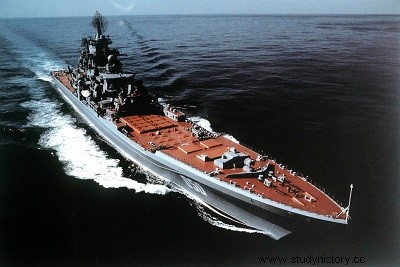
History
Kirov-class or Project 1144 nuclear-powered cruisers (CGN, according to the US Navy ship registry code list) are the largest and most powerful in service in the Union of Soviet Socialist Republics and today. still in Russia.
History
The first copy, the Kirov, was launched in 1977 and was joined by two other ships towards the end of the 1980s and the last in 1998. These “aircraft carrier killers”1 have slightly different weapon systems one another. It was planned to build five, but the last one was left as a project.
After the fall of the USSR, the economic situation no longer made it possible to maintain in service all of this class, the most powerful of surface ships built in this State but also expensive to maintain. Only one was in active service in the 2000s:
Peter the Great (Piotr Velikiï, ex-Yuri Andropov) which was the last to enter service is currently the flagship of the Northern Fleet,
Admiral Ouvhakov (ex-Kirov ), placed in reserve in 1990 following an accident, was dismantled in 2003;
Admiral Lazarev (ex-Frounze) was laid up in July 1999;
Admiral Nakhimov (ex-Kalinine) has been docked in Severodvinsk since 1999 for lack of maintenance of its nuclear reactors. In 2008, several sources indicated that the latter would be put back into service in 20122, but in the end, it was on June 13, 2013 that a contract worth 50 billion rubles (1.1 billion euros) for its modernization is signed for a return to service around 2018. It is announced that 70% of the cruiser's equipment must be dismantled and replaced.
Note that an intelligence gathering ship serving as a command center based on the same hull, the SSV-33 Ural, was in service from 1989 to 2001.
Armament
Most of the weapons are near the front of the ship, leaving room at the stern to fit the helicopter hangar below deck. The latter are used for anti-submarine warfare and for guiding the 3M45 missiles of the P-700 Granit system (NATO code:SS-N-19 Shipwreck). These missiles (20 in number) are the main weapons of the Kirovs, they have a speed of Mach 2.5 and are placed below deck in containers inclined at 45°. The anti-aircraft defense system is an S-300F equipped with the 5V55R surface-to-air missile (NATO code:SA-N-19 Grumble) (12 vertical launch systems of 8 missiles each). These missiles are about 7 m long and have a range of 10-100 km and a maximum altitude of 30 km, they are capable of destroying cruise missiles. Close anti-aircraft defense is provided by the Osa-M system and its 9M33 missile (NATO code:S-N-4 Gecko) and 30 and 100 mm guns. Finally, for anti-submarine warfare, the Ka-25 and Ka-27 armed with torpedoes are assisted by 85R missiles (NATO code:SS-N-14 Silex) and 533 mm torpedoes.
In 2013, for the return to service announced in 2018 of Admiral Nakhimov, the following armament is speculated:
30x8 "Polyment-Redut" anti-missile missiles (S-400/S-500)
8x8 "Morpheus" anti-missile missiles (short range)
1 100 mm caliber A190 artillery piece 4
4 AK-630 anti-aircraft defense guns
1 Puma 02 system (version of the AK-630 )
4x4 324 mm caliber torpedo launcher anti-submarine/anti-torpedo "Paket-NK"5
30 x 8 vertical launch system UKSK6
Jobs/Abilities
The Kirovs have advanced systems that allow them to act as command ships, to accompany Admiral Kuznetsov or future Russian aircraft carriers, or to act independently.

Technical features
Type Nuclear Powered Cruisers (CGN)
Length 248.0 m
Maître-bau 28.0 m
Draft 8.8 m
Displacement 22,000 tons (standard) 28,000 tons (full load)
Propulsion hybrid:2 conventional reactors and boilers
Power 150,000 hp (111,885 kW)
Speed 32 knots
Military features
Aircraft 3 anti-submarine warfare/missile guidance helicopters Ka-25 Hormone and Ka-27 Helix
Range of action almost unlimited due to nuclear hybrid propulsion
Crew 800 men
